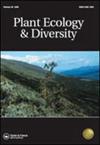加拿大高北极极端环境下沿海拔梯度的植物生殖物候
IF 1.6
4区 生物学
Q2 PLANT SCIENCES
引用次数: 1
摘要
摘要背景加拿大北极高地的极端环境正在经历前所未有的气候变化,气温上升幅度是全球平均水平的三倍。迫切需要了解北极植物的酚学将如何反应。然而,由于该地区地处偏远,长期高北极地区的酚学监测具有挑战性。目的利用海拔梯度和相关温度梯度作为气候变化的指标,预测北极植物对气候变化的表型反应。方法记录2015年加拿大努纳武特埃尔斯米尔岛海拔梯度上7种北极物种的开花和种子传播时间,并与植物高度和生长日度(GDD)测量的气温有关。结果最温暖地区开花和种子传播时间最早。五种植物的开花时间和一种植物的种子传播时间与温度有显著关系。同特异性在最冷地点开花高峰期的GDD比在温暖地点少。结论温度梯度观测提供了对酚温关系的深入了解,补充了长期监测,提高了我们了解偏远地区气候变化影响的能力。然而,应考虑物种沿温度梯度的潜在适应。这个夏天的结果应该谨慎看待。本文章由计算机程序翻译,如有差异,请以英文原文为准。
Plant reproductive phenology along an elevation gradient in the extreme environment of the Canadian High Arctic
ABSTRACT Background The extreme environment of the Canadian High-Arctic is experiencing unprecedented climate change with temperatures rising at three times the global average. There is a compelling need to understand how the phenology of Arctic plants will respond. However, long-term High-Arctic phenology monitoring is challenging due to the region’s remoteness. Aim To predict phenological responses of Arctic plants to climate change using an elevation gradient with associated temperature gradient as a proxy for climate change. Methods Flowering and seed dispersal times of seven Arctic species were recorded along an elevation gradient on Ellesmere Island, Nunavut, Canada in 2015 and related to air temperature measured at plant height and growing day degree (GDD). Results Flowering and seed dispersal times were earliest at the warmest site. A significant relationship with temperature was observed in flowering times of five species and seed dispersal times of one species. Conspecifics experienced fewer GDD at peak flowering at the coldest site than at warmer sites. Conclusions Temperature gradient observations provide insights into phenology–temperature relationships that complement long-term monitoring and enhance our ability to understand the impacts of climate change in remote regions. However, potential species adaptation along the temperature gradient should be taken into account. This single summer of results should be viewed with caution.
求助全文
通过发布文献求助,成功后即可免费获取论文全文。
去求助
来源期刊

Plant Ecology & Diversity
PLANT SCIENCES-
CiteScore
3.30
自引率
0.00%
发文量
26
审稿时长
3 months
期刊介绍:
Plant Ecology and Diversity is an international journal for communicating results and novel ideas in plant science, in print and on-line, six times a year. All areas of plant biology relating to ecology, evolution and diversity are of interest, including those which explicitly deal with today''s highly topical themes, such as biodiversity, conservation and global change. We consider submissions that address fundamental questions which are pertinent to contemporary plant science. Articles concerning extreme environments world-wide are particularly welcome.
Plant Ecology and Diversity considers for publication original research articles, short communications, reviews, and scientific correspondence that explore thought-provoking ideas.
To aid redressing ‘publication bias’ the journal is unique in reporting, in the form of short communications, ‘negative results’ and ‘repeat experiments’ that test ecological theories experimentally, in theoretically flawless and methodologically sound papers. Research reviews and method papers, are also encouraged.
Plant Ecology & Diversity publishes high-quality and topical research that demonstrates solid scholarship. As such, the journal does not publish purely descriptive papers. Submissions are required to focus on research topics that are broad in their scope and thus provide new insights and contribute to theory. The original research should address clear hypotheses that test theory or questions and offer new insights on topics of interest to an international readership.
 求助内容:
求助内容: 应助结果提醒方式:
应助结果提醒方式:


